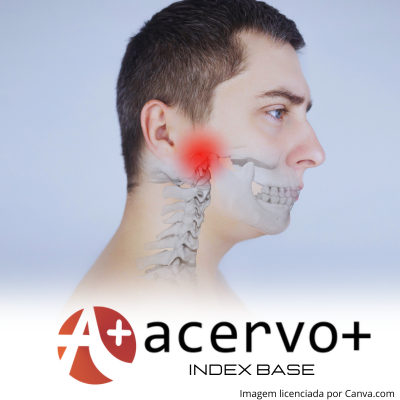Uso de bifosfonatos e o risco de osteonecrose da mandíbula
##plugins.themes.bootstrap3.article.main##
Resumo
Objetivo: Verificar se há evidências científicas que comprovem a relação entre o uso de bifosfonatos e a osteonecrose da mandíbula, bem como que outros fatores de risco podem estar envolvidos. Métodos: Revisão integrativa da literatura, incluindo estudos clínicos, randomizados, retrospectivos e prospectivos realizados a partir de 2016 para verificar as evidências científicas recentes que investigaram se os bifosfonatos aumentam o risco do surgimento de osteonecrose da mandíbula. Foram utilizados apenas artigos científicos, indexados nas bases de dados Medline/PubMed; IBECS, Lilacs e BBO-Odontologia. Resultados: Foram encontrados oito estudos que atenderam aos critérios de inclusão, permitindo constatar que a literatura sobre osteonecrose da mandíbula relacionada a bifosfonatos continua escassa em estudos clínicos randomizados com grupos controles. Porém, já há evidências suficientes que indicam haver esse risco, estando principalmente relacionados com o uso de bifosfonatos de uso intravenoso associado à ocorrência de trauma cirúrgico dentoalveolar, não apenas pelo uso exclusivo do medicamento. Considerações finais: Alerta-se aos profissionais de saúde que devem indicar aos pacientes que venham a necessitar de terapia com bifosfonatos que, antes de iniciar tal tratamento, busquem por cirurgiões-dentistas para profilaxia dentária e realizem as intervenções odontológicas que se façam necessárias, evitando ter que realizá-las enquanto estiverem em tratamento com esses medicamentos.
##plugins.themes.bootstrap3.article.details##
Copyright © | Todos os direitos reservados.
A revista detém os direitos autorais exclusivos de publicação deste artigo nos termos da lei 9610/98.
Reprodução parcial
É livre o uso de partes do texto, figuras e questionário do artigo, sendo obrigatória a citação dos autores e revista.
Reprodução total
É expressamente proibida, devendo ser autorizada pela revista.
Referências
2. ALRAHABI MK e GHABBANI HM. Clinical impact of bisphosphonates in root canal therapy. Saudi Medical Jornal, 2018; 39(3): 232-238.
3. BETH-TASDOGAN NH, et al. Interventions for managing medication-related osteonecrosis of the jaw. The Cochrane Database of Systematic Reviews, 2017; 10(10): CD012432.
4. CALVANI F, et al. Efficacy of bovine lactoferrin in the post-surgical treatment of patients suffering from bisphosphonate-related osteonecrosis of the jaws: an open-label study. Biometals, 2018; 31(3): 445-455.
5. CHAMBRONE L. Current status of the influence of osteoporosis on periodontology and implant dentistry. Current Opinion in Endocrinology, Diabetes, and Obesity, 2016; 23(6): 435-439.
6. CHRCANOVIC BR, et al. Bisphosphonates and dental implants: A meta-analysis. Quintessence International, 2016; 47(4): 329-342.
7. DE-FREITAS NR, et al. Bisphosphonate treatment and dental implants: A systematic review. Medicina Oral, Patologia Oral y Cirugia Bucal, 2016; 21(5): 644-651.
8. DEMIRCAN S e IŞLER SC. Changes in serological bone turnover markers in bisphosphonate induced osteonecrosis of the jaws: A case control study. Nigerian Journal of Clinical Practice, 2020; 23(2): 154-158.
9. HASEGAWA T, et al. A multicenter retrospective study of the risk factors associated with medication-related osteonecrosis of the jaw after tooth extraction in patients receiving oral bisphosphonate therapy: can primary wound closure and a drug holiday really prevent MRONJ? Osteoporosis International, 2017; 28(8): 2465-2473.
10. KHAN AA, et al. Case-based review of osteonecrosis of the jaw (ONJ) and application of the international recommendations for management from the international task force on ONJ. Journal of Clinical Densitometry, 2017; 20(1): 8-24.
11. LEIZAOLA-CARDESA IO, et al. Bisphosphonates, vitaminD, par-athyroid hormone, and osteonecrosis of the jaw. Could there be a missing link? Medicina Oral, Patologia Oral y Cirugia Bucal, 2016; 21(2): 236-240.
12. MANFREDI M, et al. A 5-year retrospective longitudinal study on the incidence and the risk factors of osteonecrosis of the jaws in patients treated with zole-dronic acid for bone metastases from solid tumors. Medicina Oral, Patologia Oral y Cirugia Bucal, 2017; 22(3): 342-348.
13. MANZANO-MORENO FJ, et al. Impact of bisphosphonates on the proliferation and gene expression of human fibroblasts. International Journal of Medical Sciences, 2019; 16(12): 1534-1540.
14. MENDES V, et al. Impact of bisphosphonate therapy on dental implant outcomes: An overview of systematic review evidence. International Journal of Oral and Maxillofacial Surgery, 2019; 48(3): 373-381.
15. MÜCKE T, et al. Prevention of bisphosphonate-related osteonecrosis of the jaws in patients with prostate cancer treated with zoledronic acid - A prospective study over 6 years. Journal of Cranio-Maxillo-Facial Surgery, 2016; 44(10): 1689-1693.
16. NICOLATOU-GALITIS O, et al. Medication-related osteonecrosis of the jaw: definition and best practice for prevention, diagnosis, and treatment. Oral Surgery, Oral Medicine, Oral Pathology and Oral Radiology, 2019; 127(2): 117-135.
17. PATNTIRAPONG S, et al. Inhibition of macrophage viability by bound and free bisphosphonates. Acta Histochemical, 2019; 121(4): 400-406.
18. PEXE M, et al. Estudo retrospectivo da osteonecrose dos maxilares associada ao uso de bisfosfonatos sem exposição óssea clínica. Revista Salusvita, 2018; 37(4): 867-878.
19. QUINTANA-GONZÁLEZ M, et al. Estado cualitativo y cuantitativo óseo generalizado en la osteonecrosis de maxilares. Efecto de los bifosfonatos. Revista de Osteoporosis y Metabolismo Mineral, 2019; 11(2): 55-63.
20. SHUDO A, et al. Long-term oral bisphosphonates delay healing after tooth extraction: a single institutional prospective study. Osteoporosis International, 2018; 29(10): 2315-2321.
21. TAGUCHI A, et al. Adequate Treatment of Osteoporosis (A-TOP) research group. Incidence of osteonecrosis of the jaw in Japanese osteoporosis patients taking minodronic acid. Journal of Bone and Mineral Metabolism, 2019; 37(5): 886-892.

